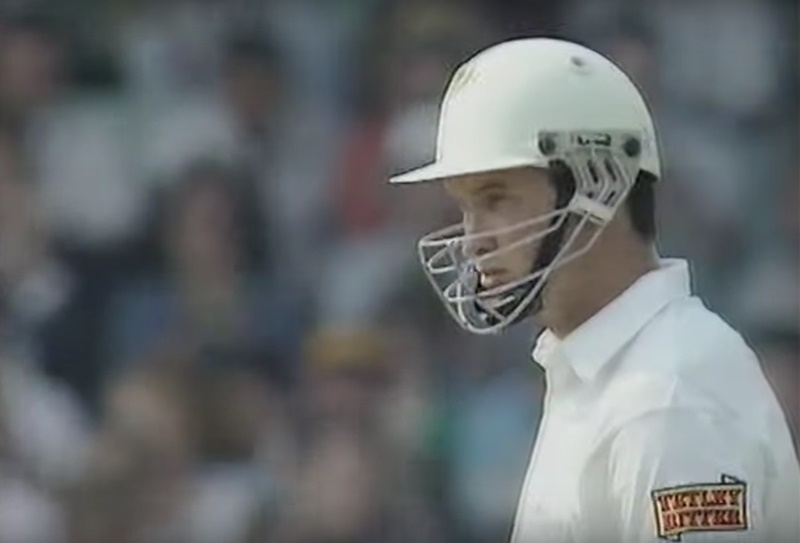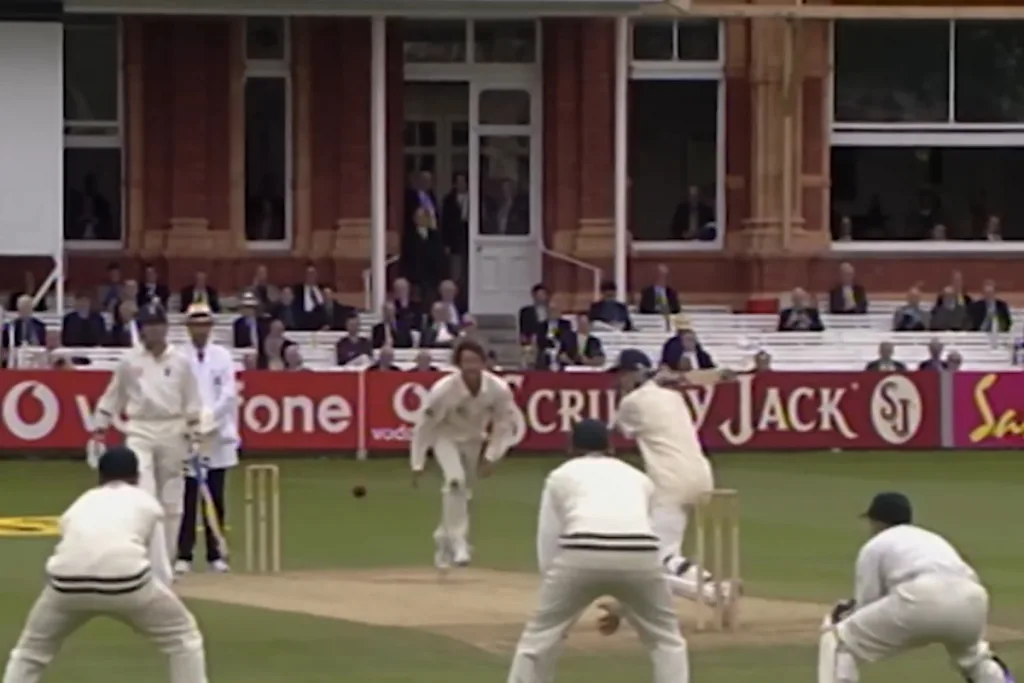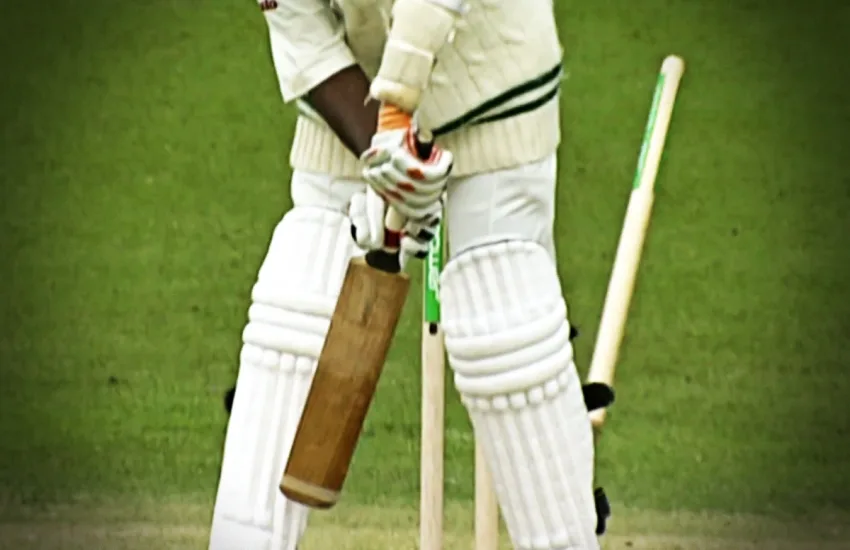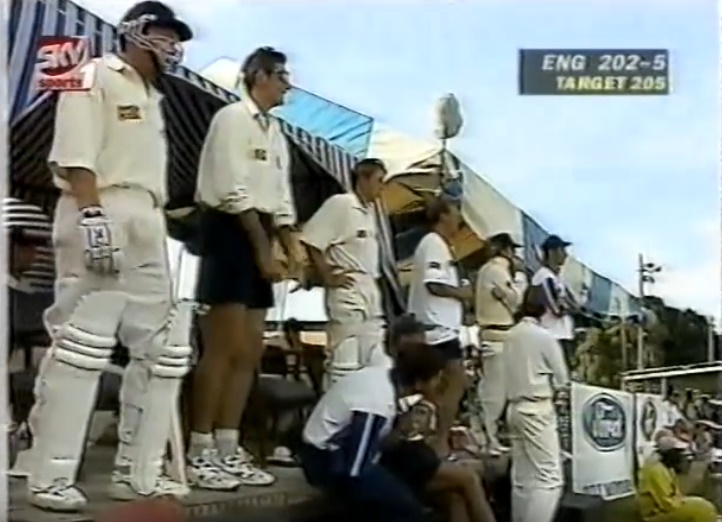Those of us chipping away the verdigris have a pretty good idea what an early summer England v Zimbabwe Test is all about – but at the same time… man, it’s been a while. All previous England v Zimbabwe matches arrived in a very narrow window between May 2000 and June 2003. Some things don’t change though. We’re pretty sure of that.
The teams have changed, obviously. This will be the first Test the tourists have played here without Heath Streak and Grant Flower in their ranks and the first time they’ve faced a side shorn of Alec Stewart and Nasser Hussain.
But – we’ll say it again – some things don’t change. Here are half a dozen things that happened in those England v Zimbabwe Tests. Let’s see if they take us to a place where we get a whiff of some sort of recurring quality that might routinely be found in these fixtures.
1. Graeme Hick made his final Test hundred

As a child, we watched an unjustifiably large percentage of a film that we’d guess was either the 1932 Western, The Night Rider, or the 1939 Western, The Night Riders.
Whatever it was, it was in black and white and set in the Wild West and despite our expectations, at no point did David Hasselhoff make a belated and striking entrance, in so doing abruptly switching the film’s narrative, colour palette, era, location and subject matter.
We think of this crushingly disappointing day often. It’s an example of how the human brain can continue to explain away extreme unlikelihood if it first began with a sufficiently strong and emotionally loaded expectation of seeing a particular thing.
In May 1988, Graeme Hick, batting at three, made 405 not out after Worcestershire had fallen to 132-5, on a pitch where Somerset were then bowled out for 222 and 192. He didn’t play his first Test until June 1991.
That would be quite the wait at the best of times, but this was not the best of times. England gave debuts to the likes of Tim Curtis, Rob Bailey and John Stephenson in the intervening period and won only four of their 27 Tests – one of which required Graham Gooch’s 333.
So when Hick did finally arrive and didn’t quite turn out to be what we all expected, many of us were prepared to keep watching. We talked ourselves into believing the talking car might yet arrive and every now and again we’d hear Mr Feeny’s distinctive timbre on the wind and convince ourselves the ‘Turbo Boost’ button was on the cusp of being pressed.
Hick’s first Test hundred was 178 against India at the Wankhede. India still won by an innings though, thanks to Vinod Kambli and England’s other batters. He only made five other tons (plus the infamous 98 not out).
The last of those was 101 against the country of his birth. It came in the first Test Zimbabwe ever played in England in the summer of 2000. Most of those runs were made in partnership with Stewart, who made 124 not out.
England secured an innings victory, in large part because…
2. Ed Giddins got wickets
Zimbabwe were still relatively new to Test cricket in 2000. We can convey just how new by setting a couple of stats alongside each other.
When they were bowled out for 83 in the first innings of the match, it was their second lowest Test total. That same innings also featured their then record sixth wicket stand between Neil Johnson and Guy Whittall. They made 19 runs together. That is not a typo.
These days Giddins is best remembered for his batting, which Cricinfo’s Martin Williamson described as “in the sub-rabbit class”. On his debut, he came in below not just Alan Mullally, but also Phil Tufnell. (One of the defining moments of England’s 90s cricket.)
He’s also remembered for cocaine and betting bans. Reporting on the former, Christopher Martin-Jenkins wrote that, “The committee rejected Giddins’ contention that he had ingested the drug inadvertently…”
This was his second Test appearance and he took 5-15 in the first innings, beginning a new tradition of peripheral, second-choice bowlers taking a load of cheap wickets against Zimbabwe and no-one knowing how to value those performances.
He played two more Tests: the second and final Test of the series and the next one, against the West Indies, when he failed to take a wicket. At this point, his full name was revealed to be Edward Simon Hunter Giddins. Upon learning that he had two full names, England dropped him.
3. Chris Schofield got a game but not wickets

One man who didn’t get a bowl in that same Test match we are somehow still talking about, even though we’ve reached the third entry of six, was Chris Schofield, the young Lancashire leg-spinner wrongly perceived as promising because no-one had really seen him bowl.
There was, at the time, huge desire to unearth a leg-spinner, so it didn’t seem too mad to pick a 21-year-old. After failing to get an over in his first match, Schofield progressed to merely failing to get a wicket in his second and never played Test cricket again.
He did however play four T20 internationals in the span of six days, seven years later at the 2007 T20 World Cup – which England did not win. (Their 15-man squad also included James Kirtley, Darren Maddy, Dimitri Mascarenhas, Owais Shah, Jeremy Snape and Vikram Solanki, which gives some sense how England approached the shortest format in those days. Solanki, who was not a wicketkeeper, kept wicket in one game.)
4. Richard Johnson got wickets
Fast forward to the futuristic year of 2003 and England reprised their Giddins trick for the second Test. This time Richard Johnson was the stalwart county seamer promoted to show what he could do – a mere nine years after making a name for himself by taking all 10 wickets in an innings for Middlesex against Derbyshire.
Embed from Getty ImagesWhat Johnson could do was skittle the tourists for 94 by taking 6-33. Yet somehow the 0-67 he managed in the second innings always loomed larger. In any case, a knee injury then ended his summer.
Recalled for his second Test, against Bangladesh in Chattogram later in the year, he took 5-49 and 4-44. This earned him just enough credit to get a third game, against Sri Lanka, a month later, where 1-54 and 0-28 pretty much did for him.
5. Anthony McGrath got wickets (and runs)
Anthony McGrath exited Test cricket with a batting average in excess of 40 and a bowling average under 15. He secured this against Zimbabwe.
Embed from Getty ImagesBatting at seven in the Johnson Test, the not-really-an-all-rounder-in-any-meaningful-sense top scored with 81, having previously made 69 in his only innings in the first Test.
It was also in that first Test that he took all four of his Test wickets, including 3-16 in the second innings, where he formed one half of an unlikely strike-bowling partnership with Mark Butcher. Why have early season wickets against Zimbabwe not always been given much weight? Butcher and McGrath combining for 7-76, that’s why.
Although really the match was settled in the first innings when…
6. James Anderson got wickets

Sometimes early season wickets against Zimbabwe are significant, aren’t they? This fella James Anderson made his debut at Lord’s in 2003 and immediately took a five-for.
He took 0-65 in the second when Butcher and McGrath ran riot.
Who knows what anything means?
Please help support King Cricket by backing our Patreon campaign. We’ve as many backers as we’ve ever had, but the average monthly contribution has (entirely understandably given the state of things) significantly dropped over the last year or so. If we could make up the difference via new backers, that would be absolutely the best outcome for us because we really don’t want people paying too much for this stuff. We have no expectations that this will happen, but please at least think about it.
If you want to get a better feel for where the money goes, you can find our other features here. And if you want to find out more about the ins and outs of the Patreon campaign, you can find more details here.
If you’re new to the site, why not sign up for the email first to get a feel for what King Cricket’s about.




It was a similar pattern for a county side against the Zimbabweans. Daisy and I spent a very pleasant day at Shenley during this match:
https://www.espncricinfo.com/series/zimbabwe-tour-of-england-and-ireland-2003-61990/middlesex-vs-zimbabweans-129294/full-scorecard
Any ground with a Corn Field End has to yield a pleasant day out, don’t you think? Anyway, point is, the Middlesex centurions in that match were Robin Weston & Paul Weekes (first innings) and Owais Shah (second innings). The only Middlesex bowlers to take more than one wicket throughout that match were Paul Weekes, Chris Peploe and ‘Thos’ Hunt.
‘Thos Hunt’ did not get to play much county cricket – a career blighted by injuries. But he was part of the 2001 Middlesex team that famously beat the Australians at Lord’s. According to his Wikipedia entry, ‘Thos’ is the grandson the Lord Hunt who led the successful British 1953 expedition to Mount Everest. Insert your own jokes about “scaling great heights” (or not doing so) here.
Happy English* Test Summer Eve everyone
*and Welsh
Also:
‘Alright Mrs Muzarabani, is your Blessing playing?’
Why is this match only four days? Is this some kind of pilot or experiment for adopting this format more widely – or is it because the ECB* refused to give a lower-ranked ‘less box office’ side a proper game?
*aka the EWCB
England have played a 4-day Test before (at least two) against Ireland in 2019 and again 2023, but no-one noticed as they won them both 3 days, by 143 runs and 10 wickets respectively.
*in 3 days
The 2019 one is famous for Jack Leach making 92 as an opener but also a nightwatchman – England ended day 1 on 0/0, 1 over into their second innings.
Thanks for that. I think Zim have played some 4 day tests too, but again they didn’t in practice last that long.
Nice Jack Leach moment too (aren’t they all?).
Absolutely!
https://www.kingcricket.co.uk/raise-your-glasses-jack-leachs-three-silliest-innings/2024/04/29/